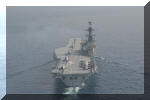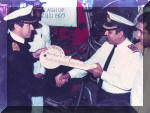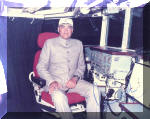HOME » INDIAN NAVY TODAY » THE SURFACE FLEET » CENTAUR CLASS
Last Updated:
15 August 2009CENTAUR CLASS
Vessel Type: Aircraft Carrier.
Name & Pennant Number with
Commission Date:
Hermes R12; Launched - 16 February 1953, Commissioned - 18
November 1959, Decommissioned - 12 April 1984.
Name & Pennant Number with Re-Commission Date: INS Viraat R22 - 20 May 1987.
Structure: The vessel has been fitted with a 12º ski jump to operate the Sea Harrier, a reinforced flight deck, 1.2 inches of armour over magazines and machinery spaces. The magazine capacity includes 80+ lightweight torpedoes. The vessel retains commando transport capability, for around 750 troops and carries four LCVP landing craft aft.
Displacement: 23,900 tons standard and 28,700 tons full load.
Dimensions:
Length - 226.5 metres.
.................Beam - 48.78 metres.
.................Draught - 8.8 metres.
Main Machinery: Has four boilers with 400 psi. Also has two geared steam turbine engines with 76,000 shp and two shafts.
Maximum Speed: 28 knots.
Maximum Range: 6500 miles at 14 knots.
Complement: 1350 (incl. 143 Officers with the air group)
Air Group:
Fleet Defense; Sea Harrier Frs Mk.51
(Capacity for 30)
..............Airborne Early Warning; Ka-31 Helix-B (By 2001)
..............ASW/ASV;
Sea King Mk.42B
and Ka-28 Helix-A
..............Cdo. Assault &
Vertrep*; Sea
King Mk.42C
*Vertical Replenishment
Radar:
Air Search; One Bharat/Signaal RAWL 02
radar at C/D-band
frequency.
.........Air/Surface Search;
One RAWS 08 radar at E-band frequency.
.........Navigation; Two BEL Rashmi radars at I-band
frequency.
.........TACAN (TACtical
Air Navigation); One FT 13-S/M system.
.........Fire Control;
Refer to 'Weapons' sub-section.
Sonar: One Graseby Type 184M hull-mounted sonar, with active search & attack capability from 6-9 khz.
Combat Data System:
Italian Elmar communication suites.
..............................SATCOM
(SATellite COMmunication) systems.
..............................CAAIS (Computer Assisted Action
Information System) action data automation; Link 10.
Weapons: The Israeli Barak SAM system has been fitted, with fire control provided by an EL/M-2221 STGR radar. Two 40mm Bofors guns are used for air defense and were accompanied by a pair of 30mm AK-230 gatling guns (for protection against anti-ship missiles) till the latter was replaced by the Barak system. Fire control for the Bofors and AK-230 guns, which were installed in 1996, were provided by a pair of Plessey Type 904 radars at I/J-band frequency. One of these radars has since been replaced with the installation of the EL/M-2221 STGR radar.
Countermeasures: A Bharat Ajanta ESM (Electronic Support Measures) is used for intercept purposes. A pair of Knebworth Corvus chaff launchers are used as decoys.
Comments: INS Viraat was originally commissioned in the Royal Navy as HMS Hermes on 18 November 1959, as the last of the Centaur Class aircraft carriers. She served as the flagship of the Royal Navy's taskforce in the 1982 Falklands conflict. She served with the Royal Navy until 12 April 1984 and was then stricken from active duty in 1985. On 24 April 1986, the Indian Navy purchased the vessel and gave it an extensive refit at the Davenport Dockyard, which gave it a life-extension refit of 10 years. This refit included new fire control equipment, navigation radars and deck landing aids. Boilers were converted to take distillate fuel and the ship was given improved NBC protection. The engine room was flooded in September 1993, which put the vessel out of service for several months. By 1995, the vessel was back in service and had a new search radar.
INS Viraat completed another life-extension refit beginning in July 1999 and ending in April 2001, which is expected to extend her serviceability till 2010. This refit included upgrading propulsion systems, a package of sensors to sound emergency alerts, a modern communication system, a long-range surveillance radar, new weapon systems, new hangar fire curtains, a revamped lift system to reduce reaction time in the event of an attack and a new flood alarm system. The vessel underwent sea trials in December 2000 and finally returned to service in early June 2001 after nearly two years in refit. The vessel also took part in the International Fleet Review in Mumbai on 17 February 2001. The vessel had to be towed back to dry dock for another refit in mid-2003 and returned to service only in November 2004, during which the vessel was fitted with the Barak SAM.
INS Viraat underwent a one year refurbishment in 2008 to further extend its life. Quoting Vice Admiral Jagjit Singh Bedi, "Virat has life in it and we will be carrying out a year-long refit starting early next year so that the ship is healthy till Gorshkov comes. It's machinery will be strengthened. It will be given a normal refit to last till Admiral Gorshkov arrives by the end of 2009 or early 2010." He also stated that no new military hardware - except a new RAWL 02 air surveillance radar - will be installed. She commenced her third & final refit at the Kochi Shipyard in mid-2008. Mail Today reported that the steam turbine engines are being overhauled, the hull is being reinforced with metal plates and her hydraulic & mechanical systems are also receiving a complete refurbishment. Captain Anil Chawla - the CO of INS Viraat - stated that the maintenance program will continue till July 2009 and she will rejoin the fleet after that. By mid August 2009, the vessel was floated in the dry docks at CSL upon completion of her latest life extension refit. She is expected to rejoin the fleet in September 2009 and serve until 2015.














